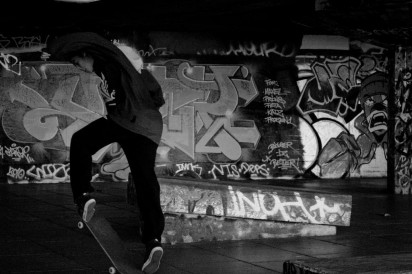Amongst the winners was East village – formerly part of the Olympic Village- which won the Mayor’s Award for Planning Excellence.
But perhaps most interesting was the winner of the Best Built Project Five Years On, awarded to the South Bank Centre’s Royal Festival Hall, for its ‘subtle yet transformative impact on the South Bank as a whole’ and its impact in ‘revitalising the complex multi-level building to significantly improve the public realm’.
This is interesting because in the very week that the SBC received a prize for planning excellence, it’s been forced to put plans for the £120m Festival Wing redevelopment on hold while it looks for an alternative funding model for the scheme. This follows a statement by Mayor Boris Johnson in January – who has final say on the application – that one of the most contentious elements of the plan – the undercroft area used by skaters and graffiti artists for nearly 40 years – must stay, conflicting with the SBC’s plans to turn the area into retail and restaurant units to help fund the redevelopment.
How could the Southbank Centre, so successful with their redevelopment of the RFH, allow things to go so wrong with their latest plans? One reason is that the SBC underestimated the opposition to their plans, a result of a failure to fully consult with the community which uses the space. As I have written previously, community consultation at pre-application stage can be hugely important in deciding whether a planning application goes ahead. It was this very “lack of consultation and poor engagement with the community” which resulted in local skaters setting up the Long Live South Bank campaign.
Another factor is the effective PR campaign of LLSB, which has been hugely successful in generating widespread public support to save the Southbank undercroft. To date it has received over 67,000 petition signatures on Change.org and delivered 27,286 objections to the plans to Lambeth Town Hall. Even more impressively, more than 100,000 people have become members of the LLSB campaign. Let’s put that into context. This means there are almost as many members of the LLSB as there are in the Conservative Party.
These statistics are symptomatic of the current disaffection with UK politicians. They also indicate that despite the political malaise, with the right message and engagement people can be mobilised to act in support of a cause they believe in. It is young people who politicians have found the hardest to engage with effectively – in the 2013 local elections only 32% of 18- to 24-year-olds voted compared with 72% of those aged over 65. Yet this is a campaign which has been spearheaded by supposedly disaffected youth.
With a membership almost numbering that of the predominant political party, the LLSB campaign represents a truly popular movement. So how did they do it? Firstly, they targeted the relevant political stakeholders who could really make a difference and addressed their petition to Boris Johnson, who has the final say in London planning. They also identified strong advocates and supporters for their campaign including Ben Bradshaw, MP and former culture secretary, Bonnie Greer OBE and skateboarding legend Tony Hawk to name but a few.
Alongside this they successfully petitioned Lambeth Council for the undercroft to be listed as an ‘asset of community value’. LLSB also employed strong messaging – emphasising the heritage and history of the Southbank undercroft as the oldest surviving skateboard spot in the world and its place as a creative, social, cultural and community hub. Use of social media and visual media including an educational campaign film also helped to make their case. But it was also a case of grass-roots activism, with London’s skateboard community and supporters joining together to campaign every single day for the preservation of the cultural space.
It’s a real shame the SBC’s plans have been put on hold, for the work they do makes a truly valuable contribution in bringing art and culture to the UK. But culture in all its forms is precious, and for now, any redevelopment of the South Bank won’t come at the expense of a treasured cultural and creative hub. Long live South Bank, in all its forms.





